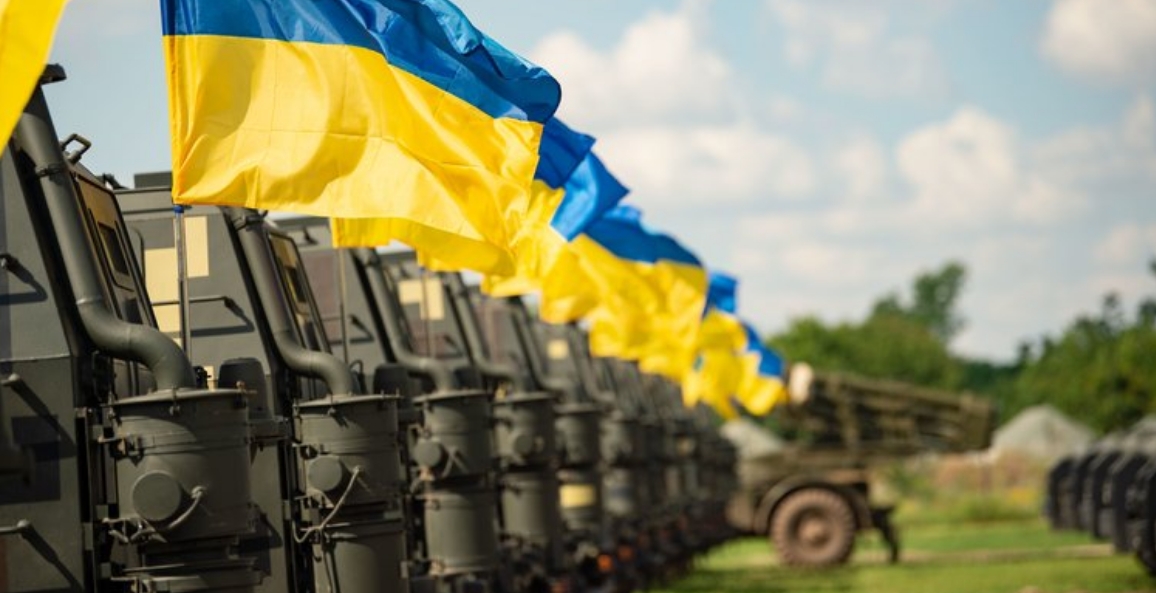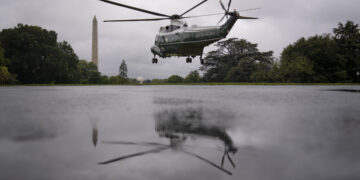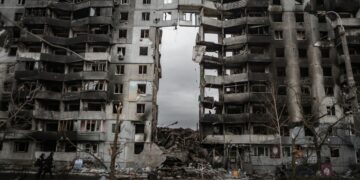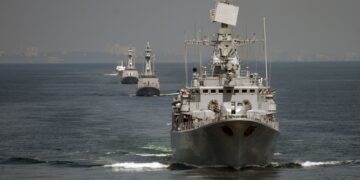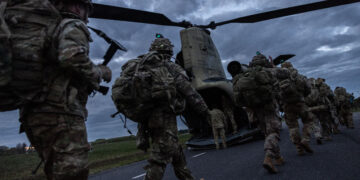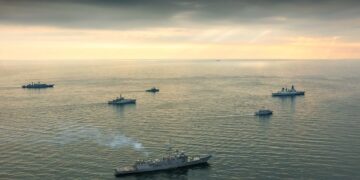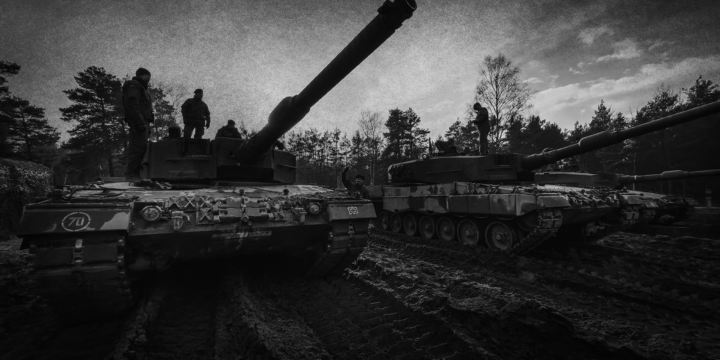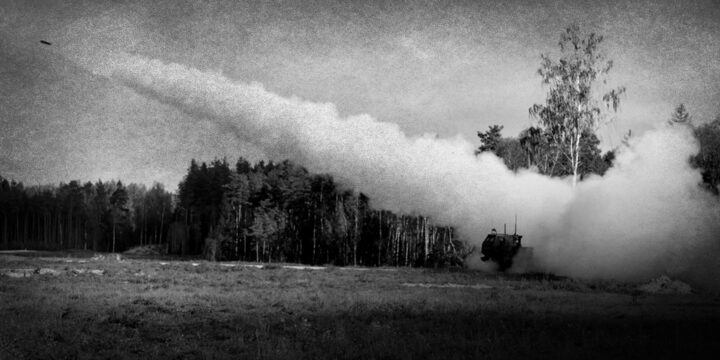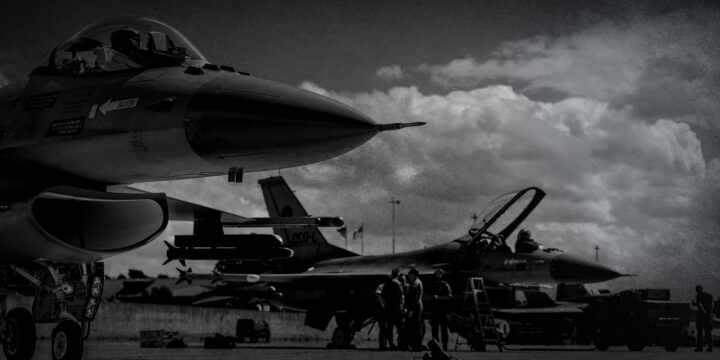As the one-year mark of the Ukraine-Russia war approaches, Moscow has failed in many of its objectives. Ukraine has effectively blunted several major Russian advances and reclaimed large swaths of its territory from invading forces. Though the war continues, and seems far from over, there are already many key takeaways from the fighting—and the conflict’s causes and implications remain hotly contested.
Defense Priorities (DEFP) organized this symposium to stimulate thinking about the most important lessons learned from this ongoing war. Top experts, writing from a range of perspectives, share their insights in an effort to inform and improve U.S. policy.
THE WAR REFLECTS THE RE-EMERGENCE OF GREAT POWER COMPETITION AND MARKS AN END TO THE UNIPOLAR MOMENT
The war in Ukraine has highlighted many facets of our rapidly changing world. It has shown the commitment of a group of Western states to support a small state in defending its sovereignty and democracy—and the limits of that commitment. It has shown the growing multipolarity of the world, with many countries opting to remain neutral towards the conflict, and it has shown the limits of that neutrality, as even states like China and India express concerns about the Russian invasion. Finally, despite claims to the contrary, the war does not mark a revival of the liberal international order.
Indeed, perhaps the most dangerous lesson that policymakers could take from the war in Ukraine is the widely touted notion that the war is a triumph of Western values and security cooperation, reinforcing the moral imperative for the United States to defend democracy everywhere. In reality, the war in Ukraine is more a reflection of the re-emergence of great power competition. In doing so, it marks an end to the unipolar moment—the period of American global dominance that followed the collapse of the Soviet Union—and heralds a period of great power competition that threatens broader conflict.
The first year of the war is also a reflection on the costs Americans are willing to bear to maintain the highly unusual level of global control and influence the United States possessed in the immediate post-Cold War period. That willingness is not infinite; polls already indicate falling support for aid to Ukraine among the American public and among some of their European counterparts. This suggests limits to the extent the American people will support similar future conflicts in places like Taiwan, and that U.S. policymakers may need to pursue more modest foreign policy goals going forward. In short, if they are to truly learn the right lessons from the war in Ukraine, U.S. policymakers should abandon the shallow triumphalism surrounding conversations about the war in Ukraine and instead seek to apply its harsher lessons to put U.S. foreign policy on a sounder footing going forward.
WILL IS STILL THE KEY FACTOR IN WAR
Ukraine stunned the world—and most professional military analysts—by repulsing a Russian invasion that was widely expected to succeed within a matter of weeks, if not days. Although massed artillery, counterintelligence, and Russian hubris were all essential to Ukraine’s survival, the most important factor was the Ukrainian will to fight. Despite the clear expectations of Russian President Vladimir Putin, his spies, and his soldiers, the Ukrainians have rallied to their nation’s defense and taken (and inflicted) enormous casualties since the beginning of the conflict. Even when temporarily enduring 10 times the volume of incoming versus outgoing artillery fire in the Donbas battles last summer, Ukrainian morale held. Reporters and foreign analysts visiting Ukraine invariably testify to the cohesion, solidarity, and unity the war has created in a country previously regarded as fractious, corrupt, and even split.
The United States is not used to partners or proxies with this kind of will and determination. After more than a decade of expensive arming and advising, the Iraqi Army nearly vanished in 2014 when faced with a few thousand fanatics in technicals. The Afghanistan National Security Forces disappeared virtually overnight 18 months ago, handing their country to the Taliban before American forces could even fully withdraw. These twin collapses were scarcely better anticipated than Ukraine’s shocking stand.
Numbers of men and material are not, and never have been, the most important variable in battlefield success. Even in an age of artificial intelligence and suicide drones, the human element remains the key determinant of victory or defeat. Potential future global security crises, Taiwan likely foremost among them, will also hinge on the will, determination, and competence of armies and the civilian populations that support them.
There is a large—if oft-contested—body of literature on military effectiveness available to those inclined to look for it. Most of it stands in opposition to the easier bean counter school of military analysis, which tallies men in uniform and tanks on parade in a wholly materialistic comparison, often buttressed by simulations and wargames. Will to fight, and the will to endure the punishment of modern firepower, is impossible to quantify and not easy to predict. But for an American superpower flanked by two oceans, with distant allies abutting its greatest potential adversaries, getting this analysis more right than wrong is essential. If America is to have any chance of implementing a sound grand strategy that takes advantage of its providential geography and forces its partners to carry their share of the load, figuring out who can and will fight is of paramount importance.
THE LOOMING THREAT OF NUCLEAR ESCALATION UNDERSCORES WHY THE UNITED STATES SHOULD SEEK A DIPLOMATIC SOLUTION SOONER RATHER THAN LATER
After one year of bitter fighting, what lessons should U.S. policymakers take from Russia’s war against Ukraine? Specifically, what have we learned about nuclear weapons and deterrence that U.S. leaders should apply to future conflicts? Although the main focus of analysis has centered on conventional military operations, and deliberate Russian attacks on Ukrainian civilian targets, the threat of nuclear escalation has loomed large in the background. Two lessons about nuclear weapons and the future of warfare deserve wide attention.
First, U.S. nuclear weapons did not fail to deter Russia’s war against Ukraine. Some claimed, especially early in the conflict, that the U.S. nuclear deterrent proved ineffective in its ability to deter Vladimir Putin from invading Ukraine. These include analysts who see Russia’s aggression as undermining to the “global nuclear order.” Such views confuse the basics of deterrence. The United States never made nuclear threats to deter a Russian invasion of Ukraine. The United States and NATO are no strangers to issuing nuclear threats to deter conventional attacks. Such threats, after all, served as the core of NATO’s strategy to protect Western Europe during the Cold War. The United States and its allies never offered Ukraine the same kind of protection. Ukraine has not received a formal Membership Action Plan required for NATO membership. And, when Russia stood poised to invade in early 2022, the United States did not issue nuclear threats to dissuade Putin from his foolish war.
Second, wars under the nuclear shadow are dangerous. Rightly, or wrongly, the Russian leadership sees the war in Ukraine as a high-stakes conflict. Russian leaders talk about Ukraine with the same urgency and determination as U.S. policymakers talked about Soviet weapons in Cuba during the 1962 Missile Crisis. In that crisis, the United States demonstrated its willingness to risk nuclear war to defend its interests. Policymakers should not assume that because the United States possesses a formidable nuclear arsenal that Russia would not use its own nuclear weapons to defend what it perceives as deadly serious interests. Putin warned, “If the territorial integrity of our country is threatened, we will without doubt use all available means to protect Russia and our people—this is not a bluff.” He further noted, “The United States is the only country in the world that has used nuclear weapons twice, destroying the cities of Hiroshima and Nagasaki in Japan. And they created a precedent.”
There are three pathways to Russian nuclear use in Ukraine. First, given the high stakes, the collapse of Russian conventional forces could create incentives for Moscow to deliberately use nuclear weapons to avoid defeat—especially in a scenario where NATO forces intervene on Ukraine’s behalf. Second, any kind of NATO military intervention in Ukraine, to establish a no-fly zone for instance, would risk inadvertent nuclear escalation. How NATO fights conventionally could look like efforts to disarm Russia of its nuclear weapons, by ripping down its air defenses and destroying its command and control. Lastly, there is the possibility of accidental nuclear escalation. Both sides will face tremendous stress to keep control of their nuclear forces while fighting an intense conventional war. These dangers underscore why the United States should work to find a diplomatic solution to end the war in Ukraine sooner rather than later.
THE UNITED STATES WILL CONTINUE DRIFTING AIMLESSLY IN THIS WAR UNTIL IT FORMS A COHERENT STRATEGY WITH A CLEAR-CUT END STATE AND ENSURES IT HAS THE RESOURCES TO ACCOMPLISH THESE GOALS
What is the most important lesson from the Russia-Ukraine war for U.S. policymakers? It’s difficult to find only one, as there are several important lessons. However, if one deserved special recognition it would be to ensure that all policies are centered on promoting U.S. national security and prosperity. Sadly, however, as the one-year anniversary of the Russia-Ukraine war nears, the United States is far from that standard.
Almost from the outset, Washington has had no guiding strategic objective or end-state. The United States has pledged to help Ukraine “for as long as it takes,” but policymakers have never defined what “help” means (and what it doesn’t mean) and haven’t answered the question: for as long as it takes to do what? Is the objective to support Ukrainian President Volodymyr Zelensky, who maintains his goal is to drive Russia completely out of Ukrainian territory, back to the pre-2014 borders? If so, then how will our current practice of providing piecemeal and limited U.S. support to Ukraine accomplish that outcome?
To date, the United States has not come close to giving Kyiv what it would genuinely take to create a potent offensive capacity—and it shouldn’t try. Such an effort would have no guarantee of success, and if Ukraine did start to drive Russian troops out of occupied territory, the potential for Russian President Vladimir Putin to resort to nuclear weapons would increase to an unacceptable level. That outcome is not in U.S. interests, and any moves toward attaining that objective should therefore be rejected.
The United States will continue drifting aimlessly in this war until it forms a coherent strategy with a clear-cut end state and ensures it has the resources to accomplish these goals. Without such a strategy, the United States will never know if what it’s doing makes any sense, has any chance to produce a positive outcome, or whether it’s expending too many or too few resources. In such an environment, the United States has a high probability of gaining nothing for all the sacrifices made and further harming its interests.
WHILE WAR IS SOMETIMES NECESSARY TO DEFEND A COUNTRY'S CORE SECURITY INTERESTS, IT SHOULD ONLY BE WAGED AS AN ABSOLUTE LAST RESORT
It’s difficult to pinpoint one core lesson from what has turned out to be a debacle of Russia’s own making. But there is one that stands out above all others: Policymakers should have a tough, honest, wholehearted debate about the costs and risks of military action; question their assumptions about how a war might evolve; and have a clear, achievable set of metrics to judge success.
It’s increasingly obvious that Russian President Vladimir Putin and his circle failed in all respects. President Putin assumed Ukraine would offer only token resistance before collapsing. Instead, the Ukrainians, with the help of more than $27 billion in U.S. military aid, have fought the Russians to a standstill. When that hypothesis didn’t pan out, the Russian high-command believed their superiority in troops and equipment would eventually overwhelm the Ukrainians in a war of attrition. Yet those same Russian commanders were apparently oblivious to the decrepit state of their armed forces, which have been incapable of instilling discipline, providing adequate equipment, and maintaining motivation within its ranks. Moscow’s ultimate objective for the campaign remains murky a year into the conflict. Russian troops at the front don’t know what the mission is and what they are fighting to accomplish.
Geopolitically, Russia is a far weaker power now than it was in February 2022. Moscow’s ties to Europe, its most profitable market, are practically severed. Putin’s decision to cease natural gas shipments to Europe in retaliation for Western sanctions has jeopardized Russia’s reputation as a dependable energy supplier. Russian military power has been exposed as hollowed out. Russia is now more dependent economically and politically on China, providing Beijing with the opportunity to squeeze out more profitable deals to Moscow’s disadvantage.
While our insight into the processes of the Kremlin is limited, it’s clear the Russian government didn’t expect any of this to happen. This in and of itself is a major indictment of President Putin’s leadership skills and the incompetency of his government. Taking a country into war is the most consequential decision a leader can make. Such a decision requires months or even years of preparation, accurate intelligence about the enemy’s military capabilities, a deep understanding of the advantages and liabilities of your own forces, and a realistic objective. If any of these requirements is shortchanged, the entire campaign is at risk of defeat.
Let President Putin’s trials and tribulations in Ukraine serve as a warning to U.S. policymakers. While war is sometimes necessary to defend a country’s core security interests, it should only be waged as an absolute last resort. If the decision to go to war is taken, the goal of the conflict must be achievable, the means must match the ends, and the sunk cost fallacy must be avoided. The alternative is to find yourself in President Putin’s shoes, with a costly, expensive, drawn-out conflict that saps your country’s wealth and power.
IT WILL BE HARD TO PERSUADE THE UKRAINIANS TO ACCEPT CONCESSIONS AND NEUTRALITY, BUT AN IMPERFECT DEAL NOW IS THE ONLY REALISTIC OPTION
The first anniversary of Russia’s outright invasion of Ukraine marks a sad milestone. The military losses on both sides have been enormous, civilians east and west of the line of contact are suffering terribly, and a negotiated end to the conflict seems more distant now than ever. Given that, it may seem Pollyannaish to search for lessons that might help us negotiate an end to the conflict, Putin’s so-called “special military operation.” But hope springs eternal, and so I offer these points for consideration.
First, it is important to remember that for those directly involved, this war did not begin on February 24, 2022, but years beforehand. Violence dates back until at least 2014 with the extraconstitutional ouster of Ukrainian President Viktor Yanukovych in the Maidan uprising, the Russian seizure of Crimea, and the outbreak of the anti-Kyiv Donbas revolt. Even these events were within the context of 20 years of vociferous Russian opposition to NATO expansion from both pro-Western liberals and nationalist hardliners. It will be difficult to resolve this war if we ignore this context.
Second, the West should very seriously consider neutrality for Ukraine, rather than pushing to have it fully on “our side.” If we in the West were honest with ourselves, keeping Ukraine outside of NATO—a core Russian demand—is in the alliance’s best interest. Bringing Ukraine into NATO before the war ends would activate NATO’s Article V mutual defense clause, putting the United States directly at war with Russia, a significant military power with nuclear weapons. But let’s be even more honest, while NATO defends the principle of the “open door” for membership to whomever wants in, the member states also recognize that Ukraine is far from the robust political democracy or open and uncorrupt market economy that the alliance desires for its members. The nightmare of Ukraine actually becoming a NATO member is that, along with Turkey, it simply adds another member which is a fragile and unconsolidated democracy with uncertain civilian control of the military and security forces and rife with corruption.
Third, we need to acknowledge that the Ukraine that became independent with the breakup of the Soviet Union was not a homogenous nation-state; given that, a division of territory may be what’s best for establishing one. The Donbas uprising of 2014, admittedly aided and abetted by Moscow, was also a reflection of the opposition of large numbers of Russian speaking Ukrainians in the east to the overthrow of the Russia-friendly President Yanukovych and the increasingly hardline Ukrainian nationalist and pro-Western orientation of the subsequent Petro Poroshenko regime. Ukraine has deep internal political divisions that have only been worsened by this war; these cannot be overlooked in the long run.
The Minsk process might have averted all-out war and maintained the territorial integrity of post-1991 Ukraine by settling the conflict in Donbas through domestic reorganization. But after a year of war, the situation in the east has changed to such an extent that the only possible basis for a negotiated solution to the conflict is Ukrainian territorial concessions. Ukraine and the West need to make their peace with the idea that Crimea, the Donbas, and the southern land bridge between them are most likely gone for good.
This would be a blow to Ukraine’s prestige, but if Kyiv looks beyond that, its leaders might see that territorial concessions offers two important benefits. First, the Russians are in the process of fortifying their gains in these territories, and a military campaign to retake them would, at best, be long, bloody, and still probably end in failure. Fighting to a victory for one side or the other seems unlikely to end the war. Second, as a result of population transfers, it is likely that most of the remaining people in these areas prefer being part of Russia. Were they under Ukrainian control, they could constitute a pro-Russian fifth column inside of the Ukrainian national project. They could also constitute the future core of ongoing violent resistance provoking long-term unrest in Ukraine. Pride aside, territorial concessions are actually in Ukraine’s long-term interest in terms of building a cohesive nation-state.
In the heat of battle, it will be hard to persuade the Ukrainians to accept concessions and neutrality, but if I am right that there is no way they can win militarily, and even doing so would weaken the Ukrainian national project and plant the seeds for another war, an imperfect deal now is the only realistic option.
THE WEST SHOULD PROACTIVELY DEFINE WITH KYIV THE OUTCOME THAT IT WOULD LIKE TO SEE IN 2023 AND EQUIP UKRAINE ACCORDINGLY
Since Russia invaded Ukraine, much ink has been spilled about Russia’s theory of victory and how it has changed throughout the war. At the beginning, Moscow hoped to achieve victory by conducting a lightning strike on Kyiv to replace Ukraine’s leadership with a puppet regime. Later, the Russian leadership attempted to establish a red line around the newly annexed regions with the intention to scare the West and Ukraine away from reconquest. The third incarnation of Russia’s theory of victory is the waiting game: to bet on Western and Ukrainian war fatigue and hope that, in a renewed offensive, quantity will wear down quality (in personnel and weapons), with the latter so far Ukraine’s advantage.
What has been less discussed is the Western theory of victory. How do Kyiv and its Western partners aim to bring this war to a decisive point in 2023? In the first year, the West’s response has been mostly reactive, equipping Ukraine with offensive or defensive weapons just in time for the next step ahead. In hindsight, this was justified with concerns about escalation risks. It was better to proceed slowly and in piecemeal fashion, like in the boiling frog story, instead of provoking the Kremlin with a sudden jump in military support for Ukraine. In reality, this was not a grand strategy, but a reflection of the political constraints in the countries supporting Ukraine.
This reactive approach needs to change, to prevent the second tragic anniversary of Russia’s invasion being followed by a third and fourth anniversary. Instead of only reacting to Russia’s actions (or inactions), the West should proactively define with Kyiv the outcome that it would like to see in 2023 and equip Ukraine accordingly. One such potential outcome could be to break up the land bridge to Crimea and isolate Russian forces in the south and east from each other, bringing Ukraine closer to the pre-invasion lines.
This year is crucial not only because of the mounting cost in human lives and the increasing political and economic effects of the war, but also because the broader political environment is unlikely to be as favorable to Ukraine as it is now. In 2024, elections in the United States will distract the leading power in this war, and support for Ukraine from a potentially Republican-dominated White House and Congress will be weaker. Furthermore, Ukraine has its own elections to manage in 2024—as has Russia, although certainly not the kind of democratic elections that will be expected in Ukraine.
The West has thwarted Russia’s “waiting game” by upping the ante with Western tank deliveries. Now it needs to devise its own theory of victory, which may not amount to a total victory for Ukraine but at least a “good enough” victory in this year, as more difficult political waters lie ahead.
THE WAR IN UKRAINE SHOWS THE STRENGTH OF DETERRENCE AMONG GREAT POWERS.
Rather than heralding a new era of instability and nuclear brinkmanship as some contend, Russia’s invasion of Ukraine has shown the robustness of nuclear deterrence and the durability of the great power peace.
A conventional interpretation of the war sees it as an indication not only of Russia’s wider appetite for conquest, but also emblematic of a globally destabilizing trend where bids for territorial gain recharge military competition. The war marks the end of the long era where interstate war declined and the specter of nuclear destruction kept great powers at peace, this thinking goes.
However, this war has demonstrated why invasions have become less common. Russia’s war against Ukraine has been like a global public service announcement about the perils of aggression. Russia, it seems, attacked Ukraine due to a gravely mistaken view that the cost would be low. As with the U.S. invasion of Iraq, that expectation proved wrong. Laying aside the substantial cost of sanctions, Russia has suffered tremendously on the battlefield, with some U.S. and European officials estimating their casualties are nearing 200,000.
Meanwhile, Russian aggression supercharged the ideology it targeted, Ukrainian nationalism, while encouraging NATO’s growth in members and budgets. The war has also demonstrated how defenders benefit disproportionately from high morale, foreign sympathy, and modern technology—especially surveillance systems and accurate munitions.
It is often argued that these lessons about the folly of aggression apply only if Ukraine retakes all its lost territory. But there is no plausible outcome where Russia’s leaders see the invasion as a success to repeat soon (whatever they say in public). Nor is Russia’s invasion of Ukraine going to be an example for China or anyone else to emulate. If there is signal that will travel so far, it is more like a flashing caution sign.
An even more troubled but popular idea about the war sees it as a failure of U.S. extended deterrence (threats to defend allies) and suggestive of the decay in the credibility of U.S. nuclear threats. But the war has actually underscored the strength of nuclear deterrence.
While U.S. policy for years recklessly encouraged Ukraine to believe that it might receive security guarantees, allowing it to eschew political compromises that might have prevented attack, Ukraine never received U.S. protection—so Ukraine was no test of U.S. extended deterrence. It was probably no accident that Russia has never tested the U.S. commitment to defend its allies with nuclear weapons, despite the implausibility of some of the more recent additions to NATO.
Meanwhile, fears of nuclear use limit escalation in Ukraine. Russia has refrained from attacking Ukraine’s NATO supporters. The Biden administration, despite its highfalutin rhetoric, has labored to avoid giving Ukraine all it wants, including by directly intervening, for fear of escalating the war.
The war in Ukraine demonstrates why such horrors have grown rarer. It underlines the stability of the territorial status quo globally, the strength of NATO’s position, and the stabilizing effect of nuclear terror.
NATO NEEDS TO BE RESTRUCTURED, WITH AT LEAST A MODICUM OF EUROPEAN STRATEGIC AUTONOMY, TO MEET AMERICA’S FUTURE SECURITY REQUIREMENTS
The war in Ukraine has once again demonstrated the centrality of U.S. leadership to NATO’s mission and operations. The United States raised awareness of Putin’s plans among allies, and it has taken the lead in rallying support for Ukraine. In the past year, it has provided more military assistance to Ukraine than all other donors combined. That is the reason why Ukrainian President Volodymyr Zelensky made his first trip out of his country since the conflict began to Washington.
None of this should be surprising. Since the end of the Cold War, European states have allowed their militaries to atrophy in the fervent belief that an enduring era of peace had dawned. During the U.S.-led War on Terror, they saw little need for maintaining weapons systems, such as tanks, that would be of little use in counterterrorism campaigns but remained indispensable for conventional combat in Europe itself. Weapons stockpiles were allowed to deplete to dangerously low levels.
For many in the United States, its role in the Ukraine conflict has been a welcomed reminder of the “indispensable” role the country plays in Europe and elsewhere on the global stage. But a sober look ahead leads to a different conclusion. Given the emergence of China as a peer competitor and the mounting strategic importance of the Indo-Pacific region, the United States needs a Europe with credible hard power capabilities that can exercise at least a modicum of strategic autonomy, not perhaps in dealing with Russia but certainly with the other security challenges it will face at home (in the Balkans, for example) and in contiguous regions. While the United States works with its European allies to bring the conflict in Ukraine to a satisfactory resolution, the lesson it should learn is that NATO needs to be restructured to meet America’s future security requirements.
With the admission of Sweden and Finland, all the major European military powers will be in the alliance. That should provide the impetus to form a genuine European pillar inside NATO—something the United States has long resisted out of concern for its ability to manage the alliance, but which now has become critical to mastering global challenges. This goes well beyond the perennial issue of burden sharing. Indeed, the alliance should abandon the goal of getting all allies to spend two percent of their GDP on defense in favor of a push for European states to elaborate a comprehensive defense policy that pools resources and develops the capabilities Europe will need to defend itself in most conventional scenarios. To be sure, Europe will still need the U.S. extended deterrence, and the United States will want to keep some residual forces in Europe—since European and U.S. security must remain tightly linked. But defense responsibilities should increasingly fall on the Europeans themselves so that the United States can shift more of its resources to the Indo-Pacific region.
EXPECT MORE SURPRISES
The first lesson of the Russia-Ukraine conflict so far is a very old one: war’s ability to surprise. Very few military experts expected Russian strategy and tactics in the first months of the war to be so deeply incompetent and Ukrainian resistance to be so determined and skillful. We should keep this in mind before making any definite predictions about the future course of the war.
A second military lesson is also old and even a constant in military history: the ability of an army that stands on the defensive in urban areas to hold superior attacking forces at bay. As more and more of the world becomes urbanized, this factor will be of crucial importance in future wars. In a shift somewhat reminiscent of developments in technology before 1914, anti-tank and anti-aircraft infantry weapons also seem to have shifted the military balance in favor of the defensive.
A second set of surprises has been on the economic and political front and illustrate another old truth: when engaged in conflicts that they have been persuaded are of genuine national importance, populations can show quite unexpected levels of resilience and solidarity.
So far, both Russia and the West have miscalculated badly over this. The Kremlin expected a divided Ukrainian population and a corrupt and unpopular government to collapse in the face of invasion. Instead, Ukraine came together in resistance. Russian President Vladimir Putin and his clique also clearly thought that the threat of a cut-off of Russian energy supplies, and resulting economic difficulties, would be enough to deter the Europeans, especially the Germans, from giving serious military aid to Ukraine.
Before the war, most Western governments obviously failed to understand the degree to which the Russian establishment viewed influence over Ukraine as a vital Russian interest for which it was prepared in the last resort to go to war. The lesson here is to listen to what the other side is saying—for Russians have been warning the West of this since the 1990s.
Once the Russian invasion began, Western governments believed that harsh economic sanctions would cripple the Russian economy, lead to popular unrest, and cause powerful sections of the elite to turn against President Putin.
None of this has happened. The Russian economy has proved surprisingly resilient and well-managed; the businessmen whom the Western media persist in calling “oligarchs” now have very little political power; and most Russians have become convinced that Russia is now engaged in an existential struggle not with Ukraine, but with the West, which it is their duty to support.
The most important lesson? Expect more surprises.
THE IDEA THAT RUSSIA’S MILITARY, STRUGGLING TO DEFEAT A MUCH SMALLER AND WEAKER NEIGHBOR, COULD POSE A THREAT TO THE MAJOR POWER CENTERS OF EUROPE IS A JOKE
Many scholars believe that U.S. policy in Europe is counter-hegemonic, as it was in the early twentieth century. In this view, the U.S. security interest in Europe is to prevent one country from dominating Eurasia. As potential hegemons, Nazi Germany and the Soviet Union led the United States to involve itself deeply in European security affairs.
The first year of war in Ukraine demonstrates beyond doubt that the Russian Federation of 2023 is not, and for the policy-relevant future will not be, a potential hegemon in Europe. Either U.S. aims in Europe have expanded dramatically over recent decades or they have always been more expansive than the conventional wisdom would suggest.
Russia has conducted its war disastrously. The Kremlin’s crazy initial concept of operations, its refusal or inability to fight with combined arms at the outset, and its failure to suppress Ukrainian air defenses were all perplexing militarily. Russia’s war crimes inflamed Ukrainian nationalism, even turning previously favorable Ukrainians against them. The Russian military has performed much worse in the field than it appeared on paper. The idea that Russia’s military, struggling to defeat a much smaller and weaker neighbor, could pose a threat to the major power centers of Europe is a joke.
In a reasonable world, it would be good news to learn that preventing hegemony in Europe doesn’t require much U.S. exertion. But the “trans-Atlantic community,” which informs elites and the public about such matters, has managed to avoid that conclusion. As Jeremy Shapiro, research director at the European Council on Foreign Relations, once wrote, “U.S. foreign policy elites’ very identity has tied them to the continuation of an approach that supports their interests as a class: an activist foreign policy of American global leadership.”
Instead of recognizing the good news of Russia’s weakness, we learn that its weakness makes it more dangerous. Other supporters of U.S. leadership in Ukraine, like Brookings Institution scholar Robert Kagan, admit that “there is no way that Putin’s conquest of Ukraine has any immediate or even distant effect on American security,” granting that the claim is “kind of ludicrous.” Rather, for Kagan, “the defense of Ukraine is a defense of the [sic] liberal hegemony.”
Everywhere you look on Ukraine policy—whether in Poland, Israel, Turkey, or in Ukraine itself—you see elites jealously defending their countries’ interests. Then, there is the United States. In our country, an insular elite has dominated the Western response to the invasion, sending tens of thousands of U.S. troops to Europe and recentering European security on the United States, at a tremendous cost in money, risk, and attention.
The ruin of the war for Ukrainians and Russians is a humanitarian tragedy, but the conclusion regarding Russia’s weakness is good news. A more prudent foreign policy elite would have taken the win.
EUROPEANS DO NOT LACK THE RESOURCES TO DEFEND THEMSELVES; WHAT THEY LACK IS THE POLITICAL WILL
The reaction to Russia’s invasion of Ukraine by the foreign policy and national security establishments of the United States and other NATO countries suggests that the Russian military poses a threat not merely to Ukraine but to all of Europe. The implication is that Europe cannot defend itself without an increased American military presence on the continent complete with a permanent deployment on NATO’s eastern front.
This is a curious conclusion considering the Russian military’s poor performance against Ukraine, a far weaker country in every conceivable index of power. Russia has suffered stunning armament losses, serial logistical failures that have deprived frontline troops of basic necessities, shocking casualty rates, and a manpower shortage that has forced Moscow to rely on private armies (Yevgeny Prigozhin’s Wagner Group and Chechen leader Ramzan Kadyrov’s fighters) and conscript 300,000 additional soldiers.
Europe vastly overshadows Russia in population size, gross domestic product, and technological advancement. Europeans do not lack the resources to defend themselves; what they lack is the political will. Europe’s leaders cannot imagine a move toward greater self-sufficiency, let alone autonomy, because they have internalized, for more than 70 years, the mantra that they cannot protect their continent independently. Washington has fostered this lack of strategic confidence by steadfastly opposing a Europe with substantial military independence.
The status quo can change but only if Europe summons the political will to boost its military capabilities on a sustained, long-term basis so that its forces assume responsibility for key requirements, chief among them forward defense.
Europe remains far from that point. The latest report from Germany’s Parliamentary Commissioner for the Armed Forces, Eva Högl, listed serious deficiencies across the board in the Bundeswehr—the army of Europe’s wealthiest country.
Several European have pledged to boost defense spending following Russia’s invasion of Ukraine, but the fate of past commitments, notably the failure of many alliance members to meet the 2014 Wales Summit guidelines on military investments, justifies skepticism that the latest promises will be kept. Even if promises are not kept, the current, outmoded arrangement for defending Europe should be reassessed. During the Cold War, America guaranteeing Europe’s defense made sense. It no longer does today.
THE UKRAINIAN MILITARY, PROPERLY SUPPLIED WITH WESTERN WEAPONS AND AMMUNITION, CAN DEFEAT RUSSIA OR MAKE ENOUGH PROGRESS ON THE BATTLEFIELD TO FORCE AN ACCEPTABLE SETTLEMENT
As the one-year anniversary of Russia’s February 2022 invasion of Ukraine nears, a key lesson for Moscow and Ukraine’s supporters in the West is not to underestimate the Ukrainian military. The Kremlin and Russian general staff clearly did not understand their foe, believing the Russian military would quickly take Kyiv, depose the Ukrainian leadership, and occupy as much as the eastern one-half to two-thirds of Ukraine. Russian forces launching from Belarus toward the Ukrainian capital reportedly received only three days of food rations.
The attack on Kyiv failed, and in late March, the Russians retreated from northern Ukraine and adapted their goal to occupying the Donbas, where the Russian military has thus far failed again. The September Ukrainian counteroffensive routed Russian forces in Kharkiv, and a second counteroffensive in Kherson drove the Russian army back to the Dnipro River’s east bank. The Russian campaign now has its third commander in 11 months, Moscow mobilized 300,000 additional soldiers for its limited “special military operation” in September, and the Russian defense industry has belatedly shifted to wartime production.
Most Western analysts likewise underestimated the Ukrainian military, including this author, who expected Russia’s army to win the force-on-force fight but then face a bloody, decades-long guerilla insurgency. The Ukrainian military has shown remarkable tenacity, skill, innovation, and courage—inadvertently aided by poor tactics, leadership, and logistics on the Russian side. The belief in Washington and Western capitals that the Russian military would prevail quickly limited the arms the West originally agreed to send Ukraine. What was the point in providing sophisticated systems if the fight would be over before Ukrainian soldiers could be trained and get the weapons into the field? That set a pattern, which continues today, whereby the West provides Ukraine with heavy artillery, HIMARS, and main battle tanks only after extended internal debate and much lost time.
Ukrainian officers and enlisted personnel have rapidly mastered and put to good use Western weapons. For example, after receiving the HIMARS rocket systems, the Ukrainians quickly launched targeted attacks on Russian ammunition dumps. That disrupted Russian logistics, forcing them to move supply depots tens of miles back from the front lines.
The takeaway from the “do not underestimate” lesson is that the Ukrainian military, properly supplied with Western weapons and ammunition, can defeat and drive out the Russian military or, at a minimum, make enough progress on the battlefield that Moscow will change course and pursue a negotiated settlement on terms that Kyiv can accept. A long war offers no advantages to Ukraine or the West. Ukraine’s partners should act now to give them the capabilities, including ATACMS missiles and F-16 fighters, needed to prevail sooner rather than later.
WHEN WE TAKE ACTIONS THAT SEEM HIGHLY INIMICAL TO THE SECURITY POSITIONS OF RIVAL NATION STATES, WE SHOULD ALSO BE ALERT TO THE POSSIBILITY THAT WE MAY PRODUCE THE OPPOSITE OF THE DESIRED OUTCOMES
Preventive war is an enduring feature of international politics but is ill understood. States sometimes initiate wars because they perceive a potential opponent is on track to achieve a significant military advantage in the future, and they attack to forestall it. Discussions of Russia’s decision to invade Ukraine regularly feature the observation that Russia faced no threat of attack. This is true. Had it faced a threat of imminent attack, it would, in international law, have been licensed to wage a preemptive attack on Ukraine. That may not have been wise, but it would have been legal.
The focus on the absence of conditions that would justify preemption excludes an equally pernicious, and highly plausible, cause of this war from consideration—preventive motives that fed a decision for preventive war. Theorists of the realist school of international relations observe that when states perceive that their competitors are racing ahead of them in material power, they become concerned about future clashes of interest. In such a clash, the rising power will be able to use its advantage to either coerce a better bargain or win a contest of arms. Depending on the concerned state’s own assessment of the adversary’s intentions and the pace of change, war to “prevent” the power shift may become attractive.
Sometimes such wars literally aim to “prevent” a very specific power shift—they are about the control of material or geographical resources that would produce an advantage for the opponent. Sometimes they are simply about the rising power itself; war now with that power is necessary to forestall its progress. Notable preventive wars since World War II include the Chinese intervention in Korea in 1950 to prevent the United States from unifying the Koreas and settling its own forces on the Chinese border, Israel’s attack on Egypt in 1956 to forestall its absorption of a huge new supply of tanks and fighter aircraft from the Eastern Bloc, and the U.S. invasion of Iraq in 2003 to forestall Iraq’s possible acquisition of weapons of mass destruction.
It will be many years, if ever, before we have sufficient evidence about Russian President Vladimir Putin’s decision-making to know what his true motives were for launching this war and the relative importance they enjoyed. It is comfortable for Ukraine and its Western allies to settle entirely on inside-out explanations for President Putin’s aggression. These stress his nostalgia for the Soviet or Russian empires, nationalism, and contempt for Ukrainian culture and history. But there is at least as much evidence for the proposition that President Putin invaded Ukraine out of fear that it was on track to become a member of NATO, bringing the most powerful military alliance in history led by the United States—the most potent global military power in history—to his front, side, and back yards. It is rare for any great power to view such an event without concern.
To suggest that President Putin’s motive was preventive is not to shift all the ”blame” for the war from Russia to Ukraine or to the West. Preventive wars are indeed illegal in international law, and astute practitioners of realpolitik often counsel against them. Otto von Bismarck called preventive war, “suicide for fear of death.” Exchanging the pleasures and predictability of peace for the costs and uncertainty of war is almost always a big gamble. Powers in decline have many ways to alter a perceived poor trajectory. They can invest more in defense, find allies, and the rising power may yet encounter hiccups. But the wisdom of “restraint” is nevertheless often overlooked by the states on the losing end of a power shift.
Those who pushed hard for NATO enlargement may not wish to think about their possible share of the political responsibility for President Putin’s decision to go to war. To do so inherently undercuts some of the righteousness of the West’s passionate and principled mobilization of support for Ukraine. But we should try to learn something from this tragic war that might be of use later. When we take actions that seem highly inimical to the power and security positions of rival nation states, however attractive those actions may be on ideological, ethical, or even strategic grounds, we should also be alert to the possibility that we are pushing too hard and may produce the opposite of the desired outcomes.
COUNTRIES WITH PROUD CIVILIZATIONAL HISTORIES FORGED OUTSIDE THE WESTERN WORLD HAVE BEGUN ASSERTING THEMSELVES WITH LESS CARE FOR WESTERN CENSURE
Outside of the lessons of providing military support to a partner state in wartime and the threats posed by Russian imperial aggression, another geopolitical reality has confronted U.S. policymakers. Specifically, why has so much of the non-Western world refused to accept U.S. leadership when it comes to sanctioning Russia? China and India defied Western criticism by purchasing Russian oil and natural gas, furnishing Russia’s war chest with short term profits. Moreover, Russia secured ambivalence or even sympathy from various African countries, Indonesia, Bangladesh, and Pakistan for its war against what Russian President Vladimir Putin described as an encroaching Western hegemony. These countries tend to advocate for a negotiated settlement to the war rather than continuously arming Ukraine to fight Russia.
Not all of this is the result of Russian disinformation. Instead, it is more reflective of the coming era of multipolarity in which Western countries cannot corral widespread backing of their positions on major global issues. Few countries are actively backing Russia’s war effort (Iran, North Korea, and, in a more limited way, Syria come to mind, but each is already a pariah in the court of Western opinion).
Other nominally Western-aligned states have also disappointed the United States. When the United States asked Saudi Arabia to increase oil production via OPEC to lower prices, and hence reduce Russia’s oil profits, Saudi leaders snubbed President Joe Biden by keeping production levels as they were. Turkey has played both sides in the war, burnishing its status in NATO by supplying Ukraine with armed drones while profiting by welcoming Russian tourists.
Countries with proud civilizational histories forged outside the Western world have begun asserting themselves with less care for Western censure. It is possible to see in the wider global response to the Russian invasion a fluidity entering international relations in which concerns articulated by the United States and its European partners as existential are interpreted by other countries as being of parochial Western interest.
A major implication of this is that when the time comes to terminate the war in Ukraine, a U.S. and European position that upholds Ukraine’s right to join NATO may be met with antipathy and criticism from other major powers. The power with the greatest spoiler potential is Turkey, since its agreement is required to admit any new NATO member state. Turkey could become a representative of wider global opinion by decreeing this as inimical to ensuring lasting security in Europe.
Heading off such a potentially embarrassing outcome should become a greater U.S. priority, as it eyes an end-state to the Russian invasion of Ukraine, whether in 2023 or after.
ITS DEEP UNPREDICTABILITY AND PROFOUND CONSEQUENCES ARE WHY WAR IS SUCH A POOR INSTRUMENT OF POLICY
There are many new and hard-won lessons from the Russian invasion of Ukraine, but the most important may be an old one: “When it comes to war, none of us have any idea what we are talking about.” Nearly all political analysts failed to predict the war and nearly all military analysts failed to predict its course. In the West, we have been surprised over and over again by Russian and Ukrainian actions and capacities. We have even failed to predict our own responses. Anyone who tells you that they envisioned how this war would unfold is either a genius or a liar—and I don’t know any geniuses.
Few would disagree. Indeed, this lesson would seem banal if it weren’t for our persistent inability, or perhaps unwillingness, to learn it. I will therefore (with conscious irony) predict that this symposium will evince many prognostications about the future course of the war and the broader conflict with Russia. Nearly all will be wrong.
There is a good reason that we continually fail to learn this lesson. Our political decision-making structures and our professional incentives demand that we continue to have firm views on the future of the war. No analyst or political leader ever made a successful career out of admitting ignorance.
Unfortunately, war punishes such false certainty harshly. “War,” George Kennan reminded us at the beginning of the Iraq War in 2003, “has a momentum of its own, and it carries you away from all thoughtful intentions when you get into it. … You know where you begin. You never know where you are going to end.” In the end, its deep unpredictability and profound consequences are why war is such a poor instrument of policy.
Nonetheless, Russia and the United States, so different in most ways, both turn to military force as a policy instrument frequently and, in recent times, disastrously. This consistent behavior implies that they have misread the lessons of their past military victories. What seemed in the flush of victory to have been a triumph of purposeful policy was in retrospect just an unreproducible combination of circumstances, luck, and enemy ineptitude.
Ideally, leaders on all sides would take a certain humility on their ability to predict the course of the war, as well as an awareness of the potentially nuclear consequences of this particular conflict, into their future decision-making. In practice, we know that hubris and hope, those sworn enemies of peace, will dominate their thinking. Some lessons cannot be learned.
THE BIDEN ADMINISTRATION HAS FAILED TO ARTICULATE A COMPELLING U.S. NATIONAL INTEREST IN UKRAINE BEYOND VAGUE ASSERTIONS THAT “DEMOCRACY” AND “THE LIBERAL ORDER” ARE AT STAKE
Over the last year, American policymakers grappling with the Russia-Ukraine war have overlooked the necessity of defining the United States’ objectives in line with U.S. national interests. Instead, and to a degree not widely appreciated, the United States has engaged in progressive mission creep.
As Russia prepared and launched its attack in February 2022, the Biden administration first concluded the United States had relatively few strategic interests at play. President Joe Biden himself defined American interests in minimal terms, insisting throughout the winter and spring of 2022 that—as he put it in May 2022—“America’s goal is straightforward: We want to see a democratic, independent, sovereign, and prosperous Ukraine with the means to deter and defend itself against further aggression.” American behavior was consistent with this circumscribed objective, limiting the scope of American weapons provision to Kyiv while (1) emphasizing a variety of sanctions on Moscow as the primary penalty for Russian behavior and (2) bolstering NATO defenses as a deterrent against further Russian aggrandizement.
However, U.S. ambitions have grown since the start of the war even as initial American objectives—thanks to Ukraine’s success in resisting Russia’s initial assault—were accomplished. Hints of the trend began even as President Biden articulated his initial message, with U.S. Secretary of Defense Lloyd Austin declaring in April that the United States now wanted to see, “Russia weakened to the degree that it can’t do the kind of things that it has done in invading Ukraine.” Austin’s remarks were walked back at the time, but shades of the matter have since reappeared. Tellingly, for example, Secretary of State Antony Blinken recently argued the United States wanted Ukraine to drive Russia back to the pre-invasion territorial boundaries. Meanwhile, rumors abound that there are those in the administration seeking to empower Ukraine to take back Crimea—that is, to go beyond the February 24 lines. Whereas U.S. leaders used to insist that the war must simply end in a “strategic failure” for Russia, policymakers now speak of seeking Russia’s “defeat” and aiding Kyiv “for as long as it takes.” Compounding the matter, the limited suite of American assistance to Ukraine has progressively given way to ever greater forms of American military and diplomatic aid, so much so that Ukrainian officials openly trumpet their success in shifting the American line.
Amid these expanding aims, the Biden administration has failed to articulate a compelling U.S. national interest in further involvement in the war beyond vague assertions that “democracy” and “the liberal order” are at stake. This is a striking and troubling development. Procedurally, one would have assumed an administration touting its foreign policy managerial expertise would have internalized the problems mission creep posed in Vietnam, Iraq, and Afghanistan and the difficulties in managing creep once it begins. Strategically, one would assume an administration which came to office emphasizing competition with China and domestic renewal as their overarching priorities would have been able to pull a Nancy Reagan and “just say no” to shifting priorities in the face of events distant from core U.S. interests.
THE UNITED STATES WILL NEED TO RETHINK CREATIVELY WITH ITS ALLIES HOW TO DETER FUTURE RUSSIAN AGGRESSION AGAINST ITS NEIGHBORS
The most important lesson U.S. strategists and policymakers should take away from Russia’s invasion of Ukraine is that deterrence failed. A major European war broke out 77 years after the end of World War II, something that was unthinkable a few years ago. The United States will need to rethink creatively with its allies how to deter future Russian aggression against its neighbors.
Prior to February 24, 2022, U.S. officials made it clear to the Kremlin that they saw a military buildup that presaged a major invasion and repeatedly warned Russia of the consequences of starting a war. When Russia presented draft treaties to the United States and NATO in December 2021, the United States was prepared to discuss the security concerns raised by the Russians and to compromise on some issues, all to no avail. The Kremlin was never serious about negotiating to avoid a war.
Deterrence failed because Russian President Vladimir Putin and his inner circle do not accept the collapse of the Soviet Union as legitimate. In 1991, much of the world marveled at the relatively peaceful breakup of the USSR, after worrying that what happened as Yugoslavia broke up might reoccur in the post-Soviet space. Now we know that the violence was merely delayed for three decades. President Putin is determined to reverse the Soviet collapse by reincorporating Ukraine, Belarus, and possibly northern Kazakhstan into a new Slavic union.
Russia invaded Ukraine in order to subjugate it and install a pro-Russian government, convinced that it could win in a matter of days. President Putin’s miscalculations about the prowess of the Russian military, the weakness of the Ukrainian military, the inability of the Biden administration to respond effectively, and divisions within the European Union contributed to the failure of deterrence. President Putin believed that there would be a weak Western reaction to his invasion. Despite the robust Western response and the impressive ability of the Ukrainians to fight back, President Putin remains convinced that Russia will outlast Ukraine and its Western supporters to eventually prevail.
As long as President Putin and those around him who share an imperial mindset and nostalgia for the time when Russia dominated its neighbors remain in power, it will be difficult to deter future invasions of Russia’s neighbors. The Kremlin has also indicated that it has set its sights not only on post-Soviet states, but also on former Warsaw Pact members that, it believes, should also be part of its rightful sphere of influence.
However, once the war ends, the United States will have to redouble its efforts, along with its NATO allies and partners, to create disincentives for future Russian aggression. A new strategy of containment must acknowledge past failures to fully understand Russia’s expansive goals and dismissal of its threats as pure rhetoric. If a post-Putin leader reverses Russia’s hostile approach toward the West, then enhanced deterrence may not be needed. But until that time comes, maintaining and strengthening European security—without Russia—will remain a central challenge for U.S. policymakers.
THE UNITED STATES AND UKRAINE SHOULD AVOID MAKING LARGE SACRIFICES FOR AIMS THAT ARE SECONDARY OR UNATTAINABLE AND MOVE TO NEGOTIATE AN IMPERFECT PEACE THAT CONSOLIDATES UKRAINE’S POST-INVASION SUCCESS
Ukraine has already achieved its most important objectives in its war with Russia. Continuing to fight will provide Ukraine with only minor additional gains, if any, while imposing high costs on Ukraine and the United States. More fighting will also raise the risk of nuclear escalation. Instead, it is time for Ukraine to consolidate its successes and resolve the war on imperfect terms.
Ukraine faced a battle for national survival when Russia invaded on February 24, 2022, but this is no longer the case. The danger that Ukraine might be conquered, vassalized, or landlocked by losing its Black Sea port at Odessa has been averted. Ukraine’s military is far stronger than it was on February 24, thanks to great efforts by Ukraine and generous military aid and training from NATO states. Ukraine’s military buildup and successes on the battlefield have secured the prime Ukrainian national interests at stake in the war: that Ukraine be a free society, secure from conquest, with a viable economic base. It seems very unlikely that Russia will regain its lost momentum and threaten these core Ukrainian interests again. And if Russia somehow regains its momentum, the United States could halt a renewed Russian advance by increasing military aid to Ukraine.
Yet Ukraine’s prospects for making further military gains are also dim. Ukraine has now recovered nearly half the land it lost after Russia’s invasion. However, regaining the rest will be far harder for two reasons. First, both sides have had time to entrench and fortify their forces. This bolsters both sides’ defensive power. Therefore, expelling Russian forces from the territory they still control will be costly and could prove impossible.
Second, Russian President Vladimir Putin may escalate to nuclear use if it appears that Russian forces will be completely expelled from Ukraine, absent compensating NATO concessions. Complete and uncompensated expulsion from Ukraine would be universally seen as a major defeat for Russia. President Putin knows that things often go badly for dictators who suffer major defeats; his power and perhaps even his life would be in danger. President Putin also has a record of doubling down when faced with a setback. If cornered, he may do so again.
To move toward a settlement, the United States and Ukraine should signal to Russia that they are willing to offer concessions on four issues they refused to negotiate on before the war: a promise that Ukraine will not join NATO, a mutual pullback of NATO and Russian forces from NATO’s eastern boundaries, mutual implementation of the 2015 Minsk II accords, and U.S. and Ukrainian acceptance of Russian control over Crimea. NATO and Ukraine blundered before the war by not offering to make concessions on these issues in return for Russian guarantees of Ukrainian independence and security. It is possible that Russia would agree to a tolerable settlement of some kind, including ceding occupied Ukrainian territory, if offered these concessions now.
In a just world, Russia would gain nothing from its war against Ukraine. Instead, Russian troops would be forced from Ukraine, and Russian leaders would be tried and punished for their aggression and barbaric war crimes against the Ukrainian people. Unfortunately, Russia has the power to veto such an outcome. At the same time, Ukraine has already secured its most important war aims. The United States and Ukraine should avoid making large sacrifices for aims that are secondary or unattainable and move to negotiate an imperfect peace that consolidates Ukraine’s post-invasion success.
THIS WAR WOULD HAVE BEEN FAR LESS LIKELY IF THE UNITED STATES HAD ADOPTED A STRATEGY OF FOREIGN POLICY RESTRAINT
The war in Ukraine is a tragedy, and one that a more farsighted and realistic foreign policy could have avoided. Policymakers and concerned citizens should draw at least three important lessons from these events.
First, the war reminds us that states in the international system typically unite to oppose overt acts of aggression. It is a lesson that Russian President Vladimir Putin overlooked: In addition to believing that Ukraine would fall quickly, he appears to have assumed that NATO would not respond as vigorously as it has. The result is that Russia is now waging a war against a country backed by a coalition whose combined GDP is more than 20 times larger than Russia’s. That coalition produces the world’s most sophisticated weaponry and is weaning itself from Russian energy exports with surprising swiftness. Outside support does not ensure a Ukrainian victory, but it has turned what President Putin assumed would be a cakewalk into a protracted and uncertain slog. Russia will be far weaker in the future no matter how the war ultimately ends.
States balance against aggressors because they worry that a successful conqueror will try for more. Although moral outrage can reinforce the tendency to balance against a threatening state, third parties join forces to defeat aggressors because it is in their own self-interest to do so. World leaders hoping to seize territories they do not currently control should take this lesson to heart.
The second lesson is that “it ain’t over till it’s over.” President Putin wrongly believed the war would be quick and cheap. When the initial Russian assault on Kyiv was thwarted, Ukraine and its backers concluded that generous outside aid, fierce Ukrainian resolve, and extensive economic sanctions could inflict a decisive defeat on Russia and maybe even trigger President Putin’s ouster. Successful counteroffensives last summer reinforced Kyiv’s hopes of regaining all its lost territory, including Crimea.
Russia is still a major power, however, with more than three times Ukraine’s population and deep reserves of military equipment. Its leaders see the war as an existential conflict that Russia must win. The performance of its armed forces has improved somewhat since the beginning of the war, and its missile and drone attacks on Ukrainian infrastructure have done enormous damage. A grinding war of attrition does not favor Ukraine hence the recent rush to get Ukraine more weapons (including tanks) and training. Additional support may enable Kyiv to hold the line and make limited gains come spring, but ousting Russia from all the territory it now controls may be impossible no matter how much aid is sent. There is also the continued possibility of escalation (including the use of a nuclear weapon), a danger some pundits dismiss but which cannot be ruled out entirely.
The third lesson—and arguably the most important—is that this war would have been far less likely if the United States had adopted a strategy of foreign policy restraint. Had U.S. and Western policymakers heeded repeated warnings about the consequences of open-ended NATO enlargement (including the advice of experienced officials such as former ambassador to Russia and current CIA director William Burns) and kept Ukraine as a neutral buffer state rather than trying to incorporate it into Western security and economic institutions, Russia’s incentive to invade would have been greatly reduced. President Putin bears primary responsibility for launching a brutal and illegal war, but the Biden administration and its predecessors are far from blameless. The Ukrainian people are now suffering from President Putin’s ruthlessness, but also from Western officials’ hubris and naivete.
LOOKING BEYOND THE WAR IN UKRAINE, THE UNITED STATES SHOULD AVOID POSITIONING ITSELF AS THE SECURITY PROVIDER OF FIRST RESORT FOR POTENTIAL CONFLICTS TO COME
President Joe Biden took office intending to set priorities for U.S. foreign policy. His administration sought to focus on security challenges in Asia, along with the planetary threats of climate change and pandemics, and devote a smaller share of resources and attention to Europe and the greater Middle East. In its first year, the Biden administration withdrew U.S. troops from Afghanistan, kept Saudi Arabia at arm’s length, and pursued a “stable and predictable” relationship with Russia. Yet today, halfway into President Biden’s term, U.S. grand strategy remains almost as detached from U.S. interests as when he began.
The specific problem is that Russia invaded Ukraine. But the general problem is that in an increasingly competitive world, other states can put real capability behind their disputes with U.S. allies and partners. If the United States continues to hold itself politically, militarily, or legally responsible for solving the security problems of most of the world, it is likely to put long-term priorities aside in order to manage whatever crisis arises. That is what has happened during the war in Ukraine.
Since Russian President Vladimir Putin launched his abhorrent invasion, European security affairs have absorbed the Biden administration as well as the broader foreign policy community. Given the circumstances, one might say, rightly so. Yet those circumstances could have been different. If the United States had not spent three decades after the Cold War entrenching itself as the primary security provider for Europe, its allies might have developed better and more self-sufficient defenses. They might now be bearing much of the risks and costs that currently fall upon American citizens.
Looking beyond the war in Ukraine, the United States should avoid positioning itself as the security provider of first resort for potential conflicts to come—especially when local countries, like those of NATO-Europe, possess the wealth to support and even replace U.S. contributions, or when a region such as the Persian Gulf contains several states that could check one another in the absence of the U.S. military.
Prioritization is a theme of the latest National Security Strategy, released in October 2022. The words priority, priorities, and prioritize together appear 23 times. But prioritization is not enough to fix an American grand strategy that remains rooted in the pursuit of global primacy. The United States has taken on far-flung defense commitments and scattered its service members across the world, first during the Cold War, when such measures seemed necessary, and then during the unipolar moment, when they looked anodyne. Neither of those premises holds today. The United States must begin to relinquish some obligations in order to meet those that matter most. Otherwise, a president’s best attempts to set priorities will last only as long as the rest of the world sits still. And no one these days is sitting still.
UKRAINE HAS DEMONSTRATED THAT WE MUST LEND MORE CREDENCE TO PRACTICAL FRICTIONS AND LESS TO THEORETICAL PROSPECTS ON PHYSICAL AND DIGITAL BATTLEFIELDS ALIKE
A year of war in Ukraine has taught us to check our assumptions about the role of technology in armed conflict. The innovation so prized by our strategic culture also fosters a faulty sense of inevitability. For example, automated systems and algorithms can indeed alter the character and dynamism of the battlefield. However, the irreplaceable and irrevocably human facets of warfare—leadership, planning, logistics, organization, delegation, and morale—are still pivotal in shaping conflicts. We continue to re-learn this lesson after each so-called “revolution in military affairs.” As the military historian Martin Van Creveld wrote in 1989, “Though historical hindsight often reveals the ‘objective’ pressures towards the adoption of this or that solution, there is no question that the interaction of technology and war at any given time has been as much the product of the arbitrary and the accidental as it was of the inevitable and the necessary.”
Russia’s vaunted offensive cyber and information warfare capabilities, while unquestionably disruptive and prevalent, have proven less militarily decisive during wartime than many in the West (and even Moscow) expected. Some of this can be attributed to Moscow’s underinvestment in military cyber forces, overinvestment in propaganda, and lack of organizational coherence. But it also suggests a “ceiling of efficacy” for cyber and information operations in armed conflict writ large, which may even extend to highly skilled, well-integrated, and technologically sophisticated forces.
Some will point out there are unique facets of this conflict which cannot be extended to other geopolitical contexts, and the telemetry of Russian cyberattacks and information operations are largely classified or proprietary. This is even more of a reason to acknowledge the United States cannot grapple with its own limitations within the information domain while continuing to mythologize about Russia’s putative mastery over it. Ukraine has demonstrated that we must lend more credence to practical frictions and less to theoretical prospects on physical and digital battlefields alike.
THE UKRAINE WAR IS A LESSON IN THE IMPORTANCE OF EXERCISING STRATEGIC EMPATHY
The Ukraine war is an object lesson in the importance of exercising strategic empathy—of working to understand how powerful international actors view the world. Had U.S. policymakers taken fuller account of Russian President Vladimir Putin’s perspective, they could have avoided a series of moves that made his invasion of Ukraine (a violation of international law, for which he is of course responsible) more likely.
One such move was the George W. Bush administration’s pushing fellow NATO members to sign the 2008 Bucharest Declaration, which pledged that Ukraine would eventually join the alliance—a prospect President Putin considered a threat to Russia’s security.
The Bush administration did have one Russia expert who understood that it was playing with fire: William Burns, then the ambassador to Russia and now head of the CIA. In an email sent to Secretary of State Condoleezza Rice in early 2008 (which she shared with Secretary of Defense Bob Gates and National Security Advisor Stephen Hadley), Burns wrote that it is “hard to overstate the strategic consequences” of encouraging Ukraine to pursue NATO membership; such a move, he predicted, would “create fertile soil for Russian meddling in Crimea and eastern Ukraine.” The warning fell on deaf ears.
The Obama administration also failed to pay due attention to Russian concerns. In 2013 and 2014, U.S. officials energetically supported a protest movement that culminated in the violent overthrow of a democratically elected Ukrainian president—and then celebrated that outcome because the deposed president had pro-Russia leanings that had threatened to impede Ukraine’s integration into the West. Anyone modestly conversant in President Putin’s psychology could have predicted that he would view this American-supported regime change in the context of Washington’s expressed commitment to draw Ukraine into NATO—and thus find it strategically ominous, possibly portending a NATO naval base in Crimea.
Indeed, what followed was the “meddling” Burns had warned about: President Putin seized Crimea, and within months, Russia was giving military support to ethnically Russian separatists in the Donbas region of Ukraine (who, like President Putin, had found the “Maidan Revolution” threatening). The current war is in some ways a continuation of the war that started in 2014.
Though Ukraine didn’t join NATO after the 2014 revolution, there was growing collaboration between the two in the years before the 2022 invasion—joint exercises, training, and weapons shipments. Some Westerners thought this would deter Russian attack, but it may have had the opposite effect, convincing President Putin that he should act soon before the collaboration became more formidable. In his February 21 pre-invasion speech—which mentioned NATO 40 times—President Putin said, “Ukraine is home to ‘NATO training missions’ which are, in fact, foreign military bases. They just called a base a mission and were done with it.”
As Moscow had made clear in late 2021, the main issue that needed to be addressed if war was to be avoided was NATO: President Putin wanted written, binding assurance that Ukraine wouldn’t join the alliance. The Biden administration refused to discuss such a thing—another in a series of momentous U.S. failures to take Russian concerns about Ukraine seriously enough. Was it the last such failure? The answer to that question may determine whether this war turns into World War III.
